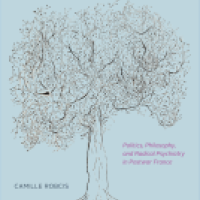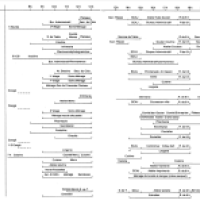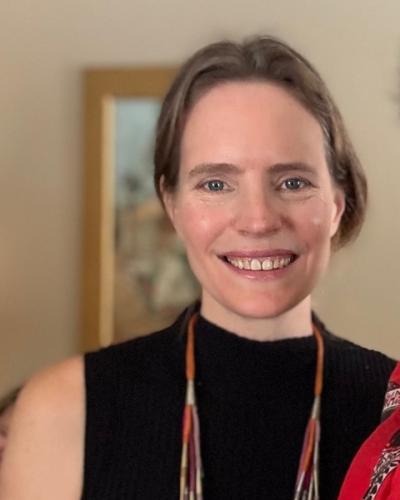This iteration of the Fellows' Q&A series features Camille Robcis, Associate Professor of History and French at Columbia University and 2013-14 "Occupation" Fellow. Her new book, Disalienation: Politics, Philosophy, and Radical Psychiatry in Postwar France, will be released in May 2021 from University of Chicago Press.
Big Picture
My book explores the conversation between radical psychiatry, politics, and philosophy in France throughout the second half of the twentieth century. More specifically, it focuses on a movement that came to be known as “institutional psychotherapy” that tried to bring together neurology, psychology, psychoanalysis, phenomenology, aesthetics, and social and political theory in an attempt to rethink the practical and theoretical bases of psychiatric care.
Institutional psychotherapy was born during the Second World War in the psychiatric hospital of Saint-Alban, a small village in central France. The context of the war played a key role in bringing together the cast of characters who laid the groundwork for institutional psychotherapy: doctors, nurses, and staff but also poets, visual artists, philosophers, and political activists who transited through Saint-Alban. Despite their various backgrounds, the residents of Saint-Alban during the war and the immediate postwar shared a vision of psychiatry as a deeply political practice. Among the most important names in the genealogy of institutional psychotherapy, we can mention François Tosquelles, Lucien Bonnafé, Frantz Fanon, Jean Oury, Félix Guattari, Georges Canguilhem, and Paul Éluard.
disalienation_cover.png
Alt Text
Disalienation cover—a tree on a light blue background.Many were doctors who had been involved in communist, anarchist, or anti-colonial politics prior to the war, and most had joined the Resistance against the Vichy regime. Others arrived at Saint-Alban because they were frustrated with the biological essentialism of mainstream psychiatry, its exclusively neurological approach to the brain, and its hostility to other disciplines. Still others joined the hospital because they were horrified by the humanitarian disaster that was taking place in psychiatric institutions, not only in Germany where the Third Reich had openly embraced eugenics and the forced euthanasia of the cognitively disabled, but also in France where the Vichy government was letting patients die of cold, starvation, and lack of care – what some historians have referred to as a “soft extermination.”
For the practitioners of institutional psychotherapy, the war and fascism had made clear the extent to which the political and the psychic were intimately connected. In this sense, psychiatry could no longer claim a position of detachment, objectivity, or pure science. Rather, it needed to reckon with its intrinsically political nature if it wanted to avoid being complicit with the genocidal practices of the war. More generally, however, institutional psychotherapy contended that psychiatry could contribute to our understanding of subjectivity and of social relations through its diagnosis of alienation. Aliénation, as the French term indicates, was a psychic state – being mad, insane – but also a social condition that made people feel estranged, trapped, and isolated from others. This is why François Tosquelles referred to Marx and Freud as the “two legs” of institutional psychotherapy – complementary figures to make sense of the human and social condition.
In Particular
One of the main hypotheses of institutional psychotherapy was that institutions – if they were thought through and organized carefully – could help alleviate the psychic and social alienation constitutive not only of psychosis but of subjectivity more generally. Indeed, from the perspective of institutional psychotherapy, the problem with institutions was not that they existed or that they generated conflicts but that they all had the potential to become “concentrationist” – authoritarian, hierarchical, oppressive, and stagnant. As such, institutional psychotherapy strove not to eliminate institutions or to suppress conflicts but rather to imagine a philosophy, a social theory, and a clinical practice that would prevent the reappearance of these political and psychic “concentrationisms” – institutions that could be constantly rethought, reworked, and remapped. This was the principle that guided all therapeutic activities within the hospital: psychiatry as a form of systematic critique, suspicious of doctrinal purity and theoretical a prioris.
It’s worth pointing out that this is one of the important ways in which institutional psychotherapy differed significantly from anti-psychiatry, which blamed institutions (including the asylum) for human unhappiness and often fought for their destruction. It is also one of the ways in which institutional psychotherapy departed most considerably from the work of Foucault who depicted institutions as sites of power, knowledge, and subjectification – and certainly not as vectors of emancipation or disalienation. In other words, for institutional psychotherapy, it was perfectly possible to be institutional and anti-authoritarian at the same time.
In the book, I spend a lot of time examining the theoretical writings of these various figures but I am also very interested in the practical experiments designed to track these “concentrationisms.” My favorite example is perhaps Félix Guattari’s “grid” (grille) at La Borde, the clinic where Guattari worked for many years.
grid.png
Alt Text
The “Grid” (la “Grille”) at La BordeThe “Grid” (la “Grille”) at La Borde ; © Revue Recherches N°21, mars 1976, Histoires de La Borde. 10 ans de psychothérapie ins- titutionnelle à la clinique de Cour-Cheverny, 1953–1963
The grid was a double-entry chart with a timetable, the names of all the staff members, and the work that was assigned to him or her each day, in rotation. According to Guattari, the grid was conceived as an instrument of “disorganization” to avoid the passivity generated by the “bureaucratic routine” and to prevent people (staff members but also patients) from getting too comfortable or too settled in their roles or identities. The grid also presented a forum through which staff members could discuss their feelings, desires, and fears, by talking and “incessantly questioning” all activities and all relationships. Ultimately, the goal was to turn the hospital into a space that could accommodate these transferential relations, a “healing collective” (collectif soignant) not only for the patients but for the entire medical team as well.
Discovery
I think I was most surprised by the importance of these practical hands-on experiments in the work of theorists such as Guattari, Fanon, or Foucault. I had been reading (and teaching!) these thinkers for years but I had not realized quite how foundational their actual work in the asylum was to understand their intellectual trajectories. I was only able to come to terms with this after following a long and extensive archival trail that led me to several of these psychiatric hospitals where I could observe how daily life was organized.
For instance, I knew of course that Fanon was a psychiatrist at the same time that he was an anti-colonial theorist and activist. But without paying close attention to his psychiatric writings, it’s hard to see how entangled his clinical practice and his politics were. Fanon thought carefully about the benefits and the limits of institutional psychotherapy in a colonial context when he worked at the psychiatric hospital of Blida-Joinville, in Algeria, from 1953 to 1957. After he was expelled from Algeria in 1957, he continued to rely on the main tenets of institutional psychotherapy in Tunisia, as he was writing his most important political texts, including The Wretched of the Earth. One of the arguments that I make in the book is that Fanon’s construction of the nation in The Wretched of the Earth is similar to the role that institutions play in institutional psychotherapy: necessary, yet always provisional and subject to critique and reevaluation.
Similarly, I don’t think we can understand Anti-Oedipus without becoming aware of how central institutional psychotherapy was for Guattari, not just at La Borde but in all his collective endeavors including the CERFI and the journal Recherches. All of these constituted essential terrains to think through and test how the insights of institutional psychotherapy could apply to broader social, political, and intellectual domains. Anti-Oedipus is a difficult book – difficult conceptually but also at the level of style. However, if we read it in conjunction with Guattari’s psychiatric/psychoanalytic activities (like the grille), it becomes clearer why Deleuze and Guattari chose to write in this way, in the hope of producing a true collective volume. Their goal was not to add two separate and distinct perspectives but to become one de-egoized voice, a true “assemblage” that would avoid all forms of closure.
Fellowship
It’s funny because when I applied to the Society, I tried (like everybody else who applies to grants!) to make my project “fit” with the yearly theme of “occupation.” But in fact, the question of psychic, social, and political occupation became absolutely central to this work and for a long time, the book’s title was actually “Disoccupation” (my editor thought it would be too obscure and we switched to Disalienation). “Occupation” in the book refers to a set of very concrete historical events: the German Occupation of the French territory during the Second World War, Spanish imperialism (that Tosquelles, a proud Catalan, deplored throughout his life), Franco’s victory in the Spanish Civil War, the Stalinist hegemonic attempt to rule over all leftist politics in the 1930s, including the POUM which marked Tosquelles’s youth, but also to colonialism, racism, and the occupation of Algeria by France that Fanon experienced firsthand in Blida.
Beyond these historical references, however, I was also fascinated by the idea of “psychic occupation” – the desire for authoritarianism, redemptive violence, and domination that institutional psychotherapy located at the root of fascism. Fascism here designated not only the fascism of Hitler, Mussolini, or Franco (so crucial to the birth of institutional psychotherapy) but also what Foucault described in his 1970s preface to Anti-Oedipus as “the fascism in our heads”: “the fascism that causes us to love power, to desire the very thing that dominates us and exploits us.” From the perspective of institutional psychotherapy, fascism was neither a failure of rationality or a political pathology as liberalism maintained, nor a “false consciousness" or a displacement of social reality, as Marxism suggested. Both of these accounts failed to understand the actual desire at the heart of authoritarianism, racism, colonialism, or misogyny. This is why for institutional psychotherapy, psychoanalytic notions such as the unconscious, desire, fantasy, transference, identification, or alienation were indispensable to make sense not only of politics, but of all group dynamics and subjective developments. As Tosquelles, Oury, or Guattari insisted, the unconscious was not an “add-on” or a supplement to social theory but rather the basis of the transferential process, the vector through which individuals and collectives could explore fantasies, conflicts and desires. Ultimately, the unconscious was the means by which the group could avoid closing on itself – and hence becoming “fascist.”
both experiments can provide us with a set of practical tools – some successful, some less so – to erode hierarchy, domination and forms of authoritarianism in group life, with the hope of ultimately opening up different political imaginaries.
In the book’s conclusion (titled “The Hospital as a Laboratory of Political Invention”), I try to link the concept of the “collective” in institutional psychotherapy to the discourse around the “common” in political theory. The “common” was another theme that recurred regularly in the fantastic conversations that I had with the other fellows at the Society since many of them were working on the anti-austerity movements triggered by the 2008 economic crisis (Occupy in the US, but also los Indignados in Spain, the Indignant Citizens in Greece, Tahrir Square in Egypt, Gezi Park in Istanbul, or Nuit Debout in France). I see many links between the ways in which these anti-austerity movements mobilized the public square and the ways in which institutional psychotherapy treated the hospital and the institution more generally. Their goal was not to issue manifestos or to strive for doctrinal coherence or theoretical purity. Instead, both experiments can provide us with a set of practical tools – some successful, some less so – to erode hierarchy, domination and forms of authoritarianism in group life, with the hope of ultimately opening up different political imaginaries.








